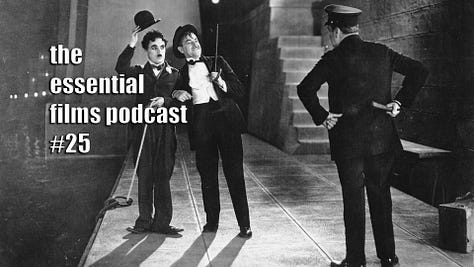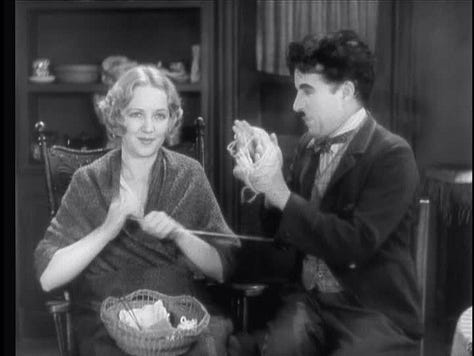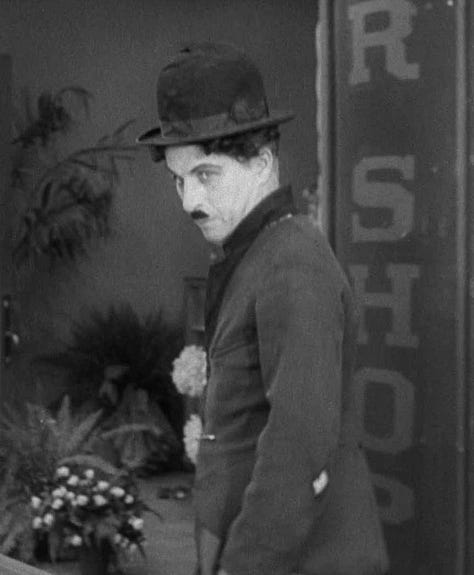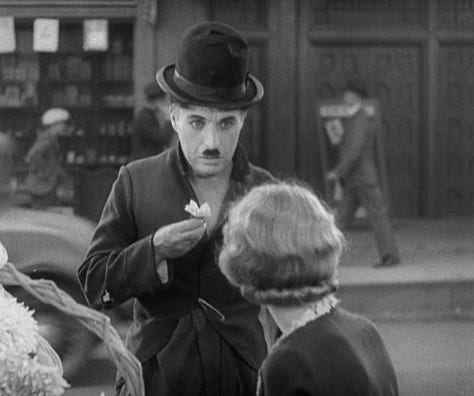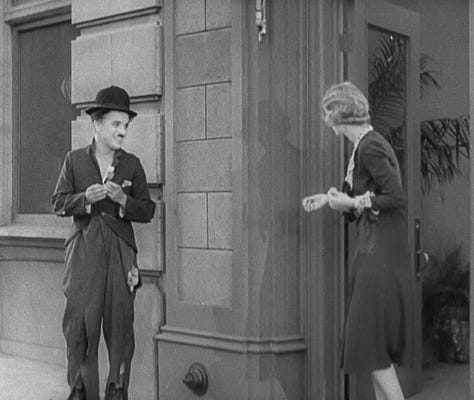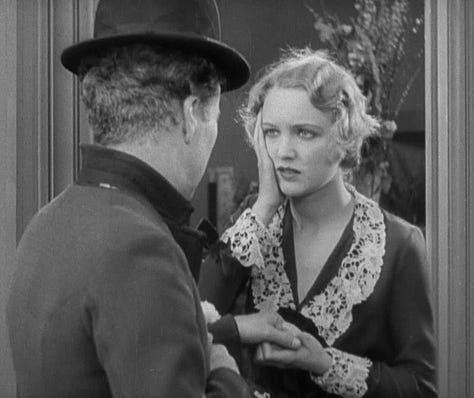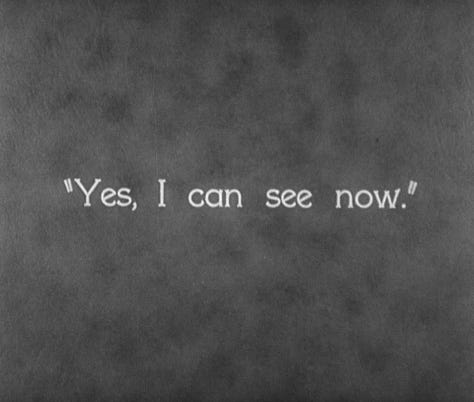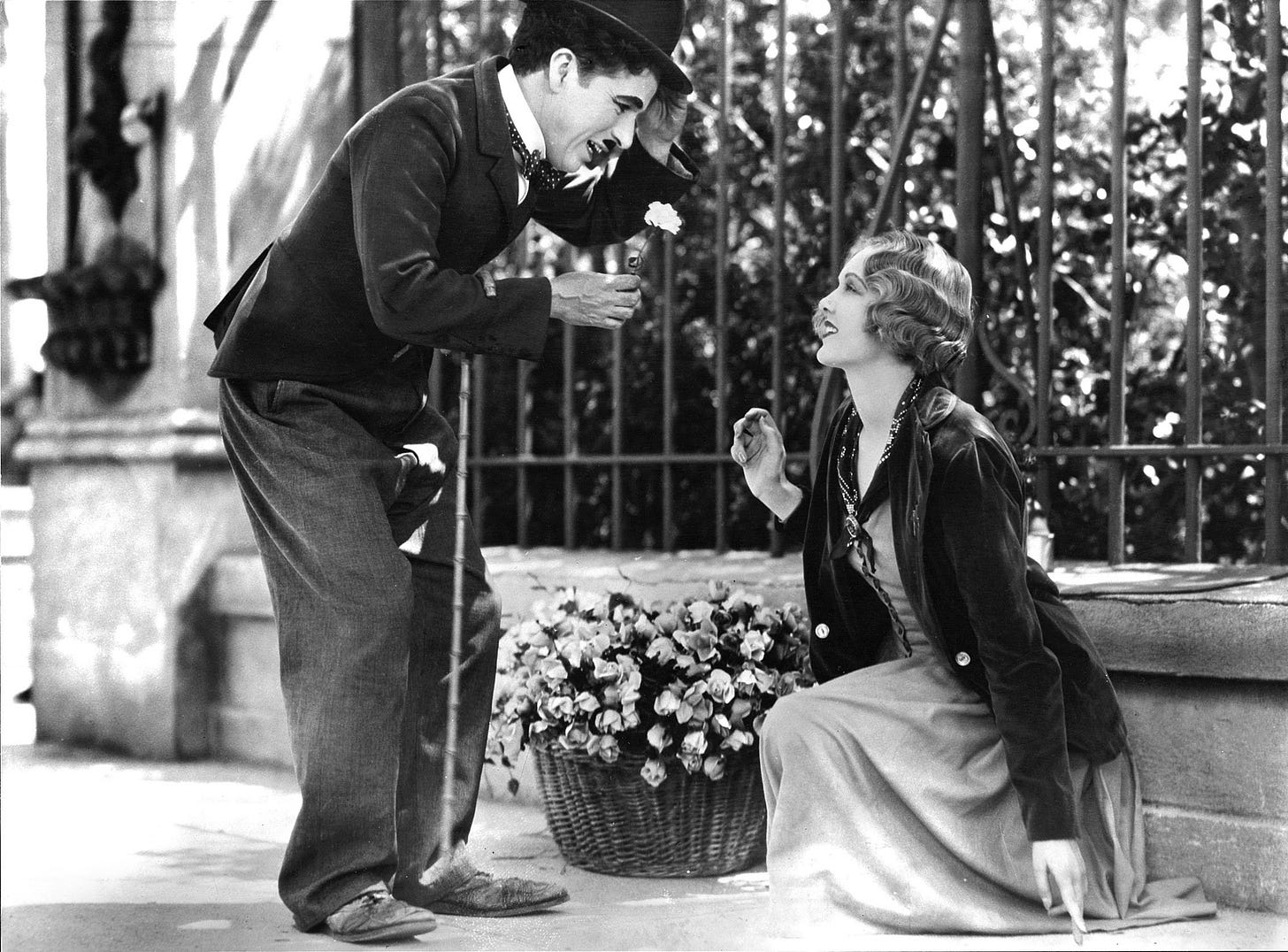CITY LIGHTS
1931 • Charlie ChaplinCast: Charlie Chaplin, Virginia Cherrill, Florence Lee, Harry Myers, Al Ernest Garcia, Hank Mann
Writer: Charlie Chaplin
Cinematography: Roland Totheroh, Gordon Pollock
Music: Charlie Chaplin, José Padilla, Arthur Johnston, Alfred Newman
Producer: Charlie Chaplin
United Artists
- Be careful how you're driving.
- Am I driving?
In the bustling streets of 1930s urban America, The Tramp, (Charlie Chaplin), stumbles upon a blind flower girl (Virginia Cherrill) selling blossoms on the sidewalk. Smitten by her grace, The Tramp becomes determined to help her regain her sight. However, things take a comic turn when The Tramp finds himself entangled in a series of misadventures, from befriending a millionaire who only remembers him when he’s drunk, to trying not to get pummelled in a boxing match, to navigating the challenges of everyday urban survival. As The Tramp inadvertently becomes the benefactor of the blind flower girl, their unconventional love story unfolds against a backdrop of societal struggles and economic disparity.
Despite the arrival of the "talkie" era, City Lights retains the charm of silent cinema, relying on Chaplin's masterful physical comedy and expressive pantomime to convey the story, emotions, and comedy. The Tramp's pursuit of kindness and connection in a world defined by disparity and hardship becomes the heartbeat of the film. Chaplin, as his iconic Tramp character, weaves a story that transcends spoken language. In a world grappling with technological advancement, City Lights harked back to the simplicity and universality of silent cinema, proving that a well-timed pratfall or a nuanced facial expression could convey more than words ever could. Each gesture, every expressive movement, and the subtleties of Chaplin's physical performance contribute to a film that is timeless and universal.
Charlie Chaplin is often hailed as one of the pioneers of silent cinema. His films were not merely comedies; they were poignant reflections of the human condition, social commentary wrapped in layers of laughter. City Lights, in particular, stands as a shining example of Chaplin's ability to blend humor with genuine, heartfelt storytelling. In many ways, City Lights is a wonderful introduction to Chaplin’s work. If you’re unfamiliar with Chapli, you will be treated to a showcase of his unparalleled physical comedy, his impeccable timing, and his unique ability to convey a range of emotions without uttering a single word. You’ll find yourself captivated by the universal themes of love, kindness, and the resilience of the human spirit.
Amid the talkie revolution that swept through the film industry, Chaplin stood resolute in his commitment to the art form that had catapulted him to international acclaim. City Lights, released in 1931, arrived at a time when dialogue had become the norm in cinema. The decision to release a silent film during this period was a bold artistic choice, reflective of Chaplin's deep connection to the cinematic language he had helped shape. In a world rapidly adapting to technological advancements, Chaplin's steadfast dedication to silence spoke volumes about his artistic integrity and his belief in the enduring power of visual storytelling. City Lights, with its absence of spoken words, was a refuge from the clamor of the talkie era.
Charlie Chaplin's reluctance to fully embrace talking pictures during the advent of the sound era was rooted in both artistic and personal considerations. Chaplin had crafted a unique brand of comedy and storytelling that relied heavily on physical expression, visual gags, and the language of pantomime. First and foremost, Chaplin had reservations about the impact of sound on his beloved Tramp character. The Tramp, with his distinctive bowler hat, toothbrush mustache, and expressive physicality, had become a global symbol of silent comedy. Chaplin worried that introducing spoken dialogue for the Tramp might dilute the character's charm and transcendence. The Tramp's humor was universal, understood by audiences across language barriers, and Chaplin feared that attaching a specific voice to the character might limit its appeal. Additionally, Chaplin was concerned about the technical challenges posed by early sound recording equipment. The cumbersome nature of early microphones and the limitations of sound technology posed challenges to the fluidity of his filmmaking style. On a more personal note, Chaplin's reluctance could be traced to his own background in vaudeville, a theatrical form that heavily relied on physical comedy.
Despite the deliberate absence of spoken dialogue in City Lights, Charlie Chaplin chose to enhance the silent beauty of his film with a musical score. Chaplin's decision to write a score for City Lights demonstrates that he understood that there could be a symbiotic relationship between music and visual storytelling. The score, composed by Chaplin himself, was not a mere accompaniment; it was an integral part of the film. The music became the “voice” of the film. It underscored the comedic beats, accentuated the tender moments, and elevated the overall viewing experience.
The blind flower girl, played by Cherrill, is portrayed as someone who admires and cherishes the Tramp, blissfully unaware of his true identity. The Tramp, in turn, becomes her silent benefactor, showering her with affection and kindness. The poignant on-screen relationship between the characters becomes a canvas for Chaplin's exploration of love and humanity. Yet, behind the scenes, the story was different. Chaplin and Cherrill's relationship was marked by a struggle for artistic control and a clash of egos. The off-screen dynamics are at odds with the cinematic magic they created on screen. Chaplin, known for his perfectionism and precise directorial approach, clashed with the relatively inexperienced Cherrill during the filming of City Lights.
The comedic heart of the film involves the side story of the Tramp and the millionaire It is an intricate dance between misfortune and absurdity, expertly choreographed by Chaplin himself. The Tramp's unexpected friendship with a wealthy man, whose perpetual attempts at suicide become a recurring motif, adds a layer of dark humor. The millionaire's unique condition of recognizing the Tramp only when intoxicated sets the stage for a series of comedic misunderstandings. It's a classic Chaplin twist that transforms a potentially somber situation into a source of endless amusement. As the millionaire's inebriated state becomes the catalyst for their camaraderie, the audience is taken on a rollercoaster of laughter and sympathy. The contrast between the Tramp's modest existence and the opulence at his disposal when the millionaire is drunk creates great satire. Chaplin pokes fun at societal notions of wealth and success with his ability to blend slapstick humor with social commentary. The Tramp's manipulation of the situation, though driven by a desire to win the affection of the blind flower girl, becomes a satirical exploration of the lengths one might go to conform to societal expectations.
City Lights clocks in at a mere 81 minutes, but within this brevity lies a profound and lasting impact. The film's remarkable ability to convey a rich tapestry of emotions and storytelling in such a succinct timeframe is a testament to Chaplin's unmatched directorial skill. However, it is in the final five minutes that City Lights transcends mere cinematic excellence to become a work of unparalleled beauty. These closing moments are not just the culmination of the Tramp's journey but of the audience’s as well. Without divulging spoilers, the final scene stands as Chaplin’s greatest achievement on screen. Chaplin crafts an emotionally resonant conclusion, an invitation to reflect on the power of silent film to evoke profound emotion. City Lights proves that true artistry is not bound by time or sound, but is found in the ability to create moments that resonate across generations.
The film holds a special place in my heart, because in 2018 I was invited by Turner Classic Movies to introduce the film on air with TCM host Ben Mankiewicz. You can watch a the behind-the-scenes recording below:
- You can see now?
- Yes, I can see now.
Notable Awards & Accomplishments
National Film Registry: Inducted in 1991
AFI's 100 Years...100 Movies (10th Anniversary Edition) – #11
AFI's #1 Romantic Comedy Film
Streaming: Max, Criterion Channel
Digital Rental/Purchase: Amazon, Google, YouTube, Vudu, Apple
Physical Media: Available on Blu-Ray and DVD. Part of the Criterion Collection
